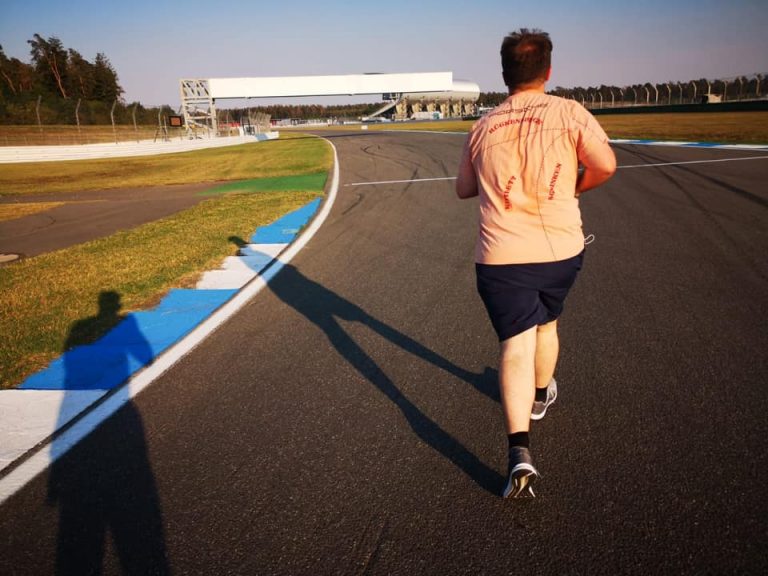It has literally been a year since I last did anything on here. Yikes.
The whole point of setting this up was a) a way to showcase my work, and b) write content that would not have a home with any of my outlets. This piece comes under b).
It’s about running. Something that 12 months ago, I didn’t do at all.
As part of a bid to start taking my health a little more seriously, I started running in January in a three-part scheme that also comprised Dry January and Veganuary. And it was great. The park near where I lived was perfect for what I wanted to do, and within a few weeks, I had some targets for the year ahead: run a 5k in under 30 minutes, and do a 10k in less than an hour. It may seem unambitious, but for a lad who once lived in 3XL shirts and took about an hour to do the 5k cross country course at school, they’d be achievements.
And an additional one was to complete some track runs. Ever since I started working in F1, track runs had been a ‘thing’ for many of my colleagues. It was a way to keep fit and run off some of the food and alcohol that tends to be put away easily following F1 around the world and managing various pressures of the job.
By February and the start of winter testing, I was all set for my first track run at the Circuit de Barcelona-Catalunya. I set a target of doing the 4.55km in under half an hour, something I managed by a 27 seconds (29:33). It felt amazing to have done it. A first step.
What I found as the year went on was that not only were my times getting quicker as my fitness improved and the weight dropped off, but more and more people were asking about the track runs. My Twitter DMs and mentions were filled with fans asking how they might also run the track. (It’s just one of the many things those of us working in the paddock take for granted about our place within F1.)
The short answer is, for the most part, you can’t. Except for circuits that run set schemes, such as the half marathon at Silverstone or the regular running events at the Yas Marina Circuit in Abu Dhabi, most of them are closed off for running.
So I thought as an end-of-year piece, it would be nice to look at each circuit I ran. Of the 12 F1 races I attended this year, I ran the track at nine of them, exceptions being Monaco (only possible if you can dodge the traffic and the throng of partygoers spilling onto the track at La Rascasse), Monza (I played football instead) and Paul Ricard (apparently as dull to run as it is to watch a race at).
For reference, I used the MapMyRun app to track all of my runs, which offers split times at every kilometre.
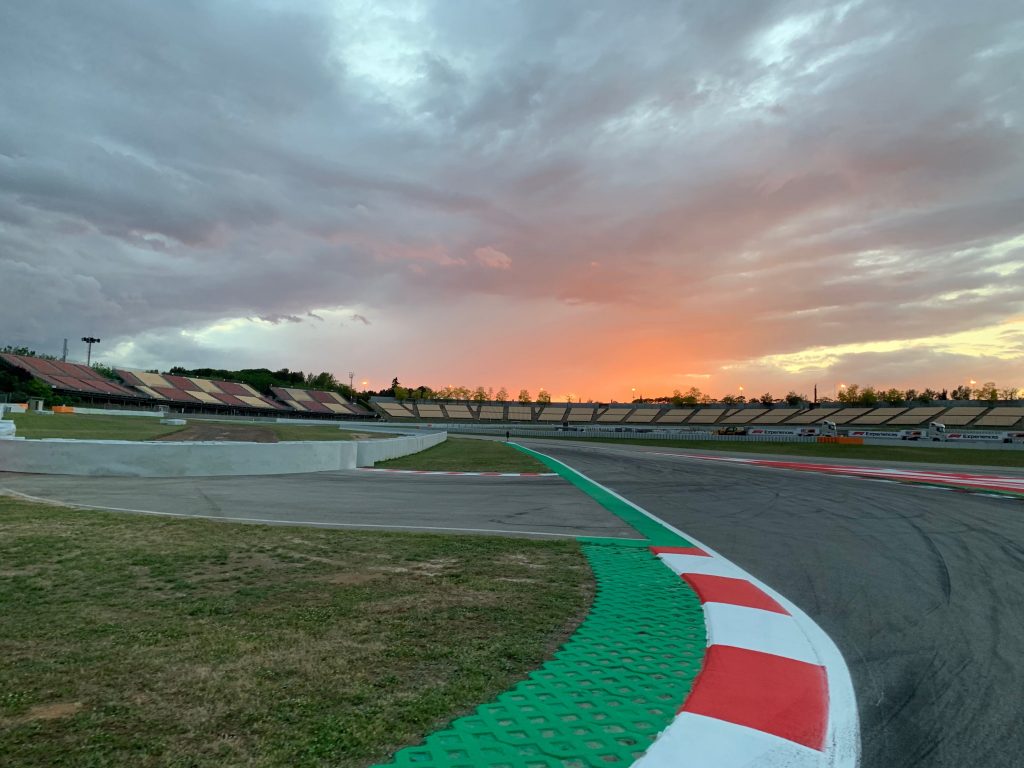
Circuit de Catalunya-Barcelona, Spain
There is absolutely nothing glamorous about testing at the Circuit de Catalunya-Barcelona. It’s cold. It’s soulless. It’s an hour outside Barcelona on a good day. Frankly, I’d be all for taking testing back to Bahrain so we can at least get some proper sun.
But nevertheless, it would be where I did my first track run during the first week of running. With most of the media centre already packed up and going home, I put on my running kit, complete with a NextEV Formula E t-shirt I was given two years ago, and went out to take on the circuit.
The run to the first corner from the start/finish line is near enough a kilometre – quarter of the way there, basically! You can feel the incline increasing through the Turn 1/2 complex before the long, never-ending Turn 3. You can’t overdo it here though – a mistake I made on my second attempt – as you’ve got two more big uphill sections to follow.
Things get a bit easier through the exit of Turn 3 as you come to a downhill section, giving your legs a break before you then reach the run up to Campsa. Again, it’s long, but the moment you get through the apex and crest the hill, things get easier – even if there’s still a long run to Turn 10.
Once you’re at that point, there’s really just one tricky complex to go. Pushing uphill into the final sector, you climb and climb until you’re midway through the short run to the right-hander at Turn 13.
And then, you push. It’s all downhill through the final chicane, and the run to the line coming out of the final corner is really short. Track run, complete!
Far from being my favourite, but still good fun once you’re in the rhythm.
I ran this track three times in 2019: once at each test, and then at the grand prix. And the gains probably showed starkest of anything how much I’d improved in the space of a few months.
Time 1 (20/2): 29:33 – 6:29/km
Time 2 (28/2): 29:19 – 6:26/km
Time 3 (10/5): 26:12 – 5:46/km
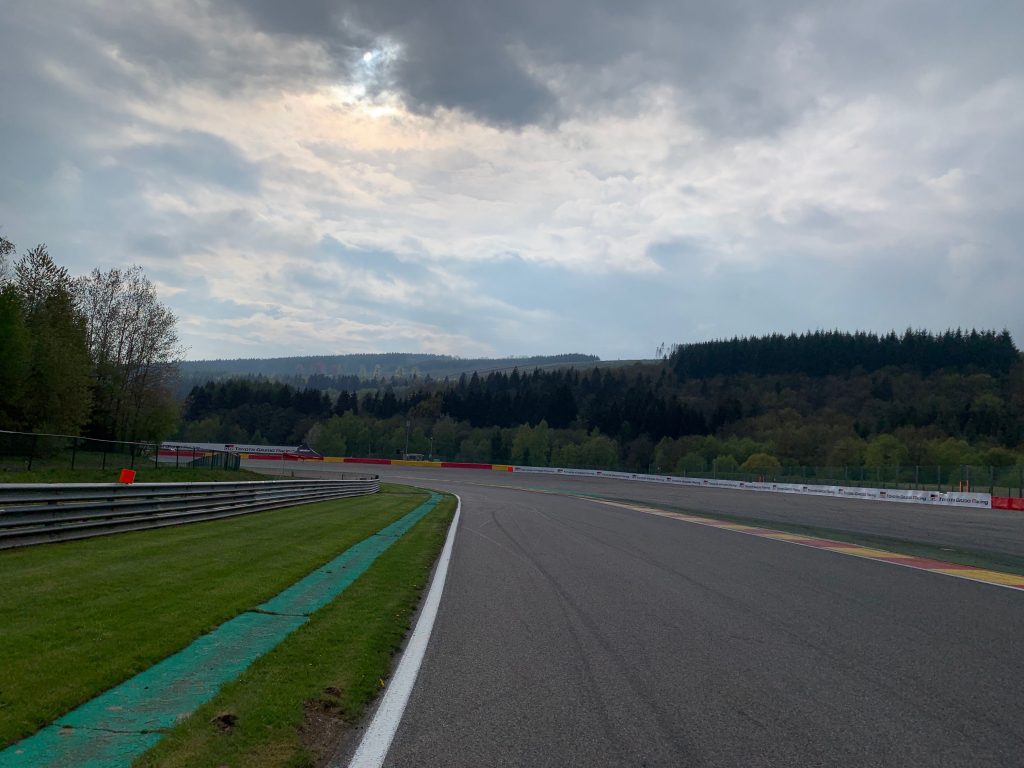
Circuit de Spa-Francorchamps, Belgium
The longest track on the F1 calendar, Spa is by far the toughest track run of the year. But I’d go as far as saying it is also the most fun.
This was the only other track I did on multiple occasions (once at the WEC round at the beginning of May, on my birthday no less! And then again at the F1). It was great both times. And it hurt a lot both times.
Eau Rouge – or is it Raidillon, actually? – is of course the hardest part of it, but there’s so much about this track that is difficult, meaning by the finish you’re dying for it to end.
The first kilometre is a breeze from the start line to the bottom of the hill at Eau Rouge. And then you start to push uphill, trying not to lose too much time as the incline gets steeper and steeper. By the time you finally get over the crest, your knees are screaming at you – and then you have the Kemmel Straight, most of which you spend recovering from Eau Rouge. As an example of just how much it takes out of you, my splits for the kilometre from the start to the bottom of Eau Rouge and Eau Rouge to Les Combes were 90 seconds apart both times around!
But you recover lots of the time that you lost as you start making your way downhill. Pouhon feels like it goes on forever, but all the while you’re going downhill, keeping it gentle enough not to batter your knees a bit more.
Pouhon also offers the most demoralising part of the track run. It’s when you take a look up, and see the paddock a long, long way above you. You’ve got all of that to make up in the remainder of the lap.
The final sector is hell. It just goes up and up and up. Blanchimont takes forever to get around. And then when you get to the Bus Stop chicane, even that is uphill.
But you exit the corner and then know respite after 7km is within sight. At the WEC race, there was a drum troop practising on the main straight as I came to the finish, making things a touch more theatric. The weird weekend schedule also meant I finished, got changed, and then went off to Toyota to speak to its drivers after qualifying, one asking if I was OK when I started coughing my guts up instead of laughing.
The F1 run felt easier, even if I could only take a minute off the run. Maybe I knew what to expect and how to pace it, but it was still tough.
Worth it? Totally. The sweet smell of Ardennes pine trees, the satisfaction at taming the track, the chance to say “I ran all of that!” – it’s the best track run of the year.
Time 1 (3/5): 43:10 – 6:14/km
Time 2 (29/8): 42:11 – 6:02/km
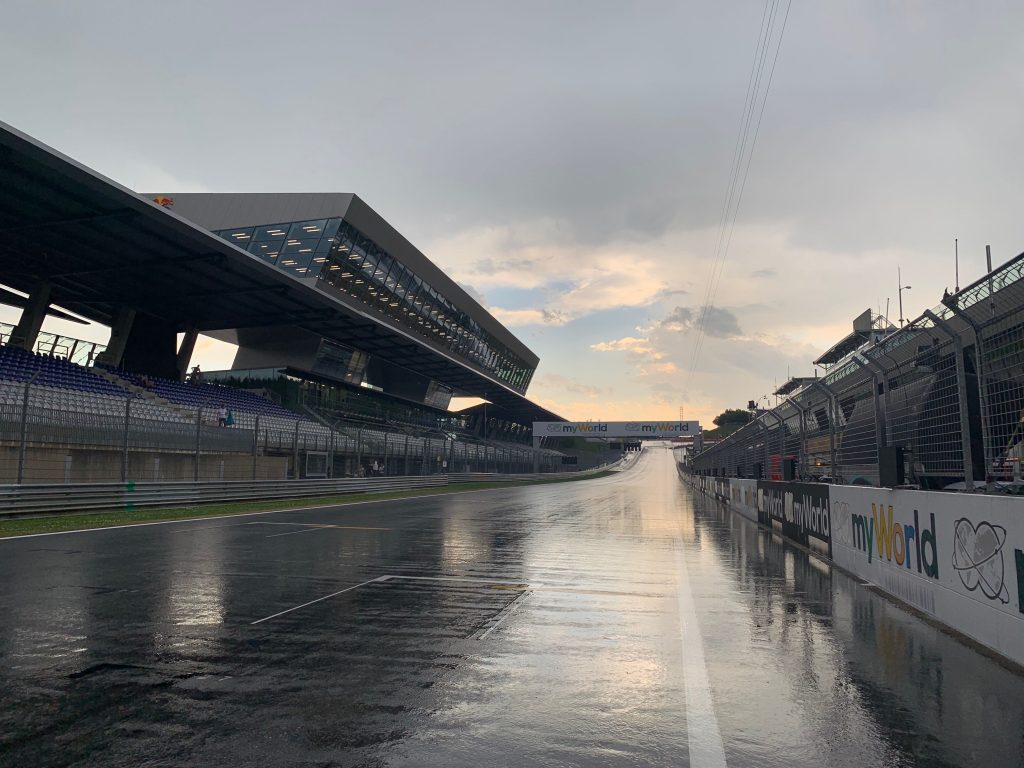
Red Bull Ring, Austria
The shortest track run of my year was probably my worst. After a rocky period that had seen me slack a bit on running, while also throwing in some dodgy travel and other stresses, I laced up my trainers to run the Red Bull Ring thinking ‘what’s the worst that could happen?’
The thunderstorm raging outside did little to allay any fears. A friend stopped her phone call to shout at me, telling me to wait for it to pass. I did, realising it was the right call as the runners who had been out when it started coming back soaked to their skin. But by the time I got out, any bit of rain falling were evaporating in the heat before they hit the ground.
This may be a short track to run, but it’s not easy. Turn 1? Uphill. You get to the ‘landing’, then you’re uphill again for the run to Turn 2/3. Turn 4 is awkwardly cambered, Turn 5 is a bit uphill, then you sweep downhill again before you come to the final sector. Which gives you another slight incline before finally, that double-right-hander to get to the finish.
It sounds easy, but it really, really wasn’t. I sprinted to the line, and proceeded to throw up on the starting grid.
“I just chundered on Verstappen’s grid slot,” I told a friend on WhatsApp. “If he wins tomorrow, you know why.” It was meant to be a joke, but I’ll take the credit for his Sunday performance, that being the only good part of an otherwise-rubbish track run.
Time: 26:19 – 6:15/km
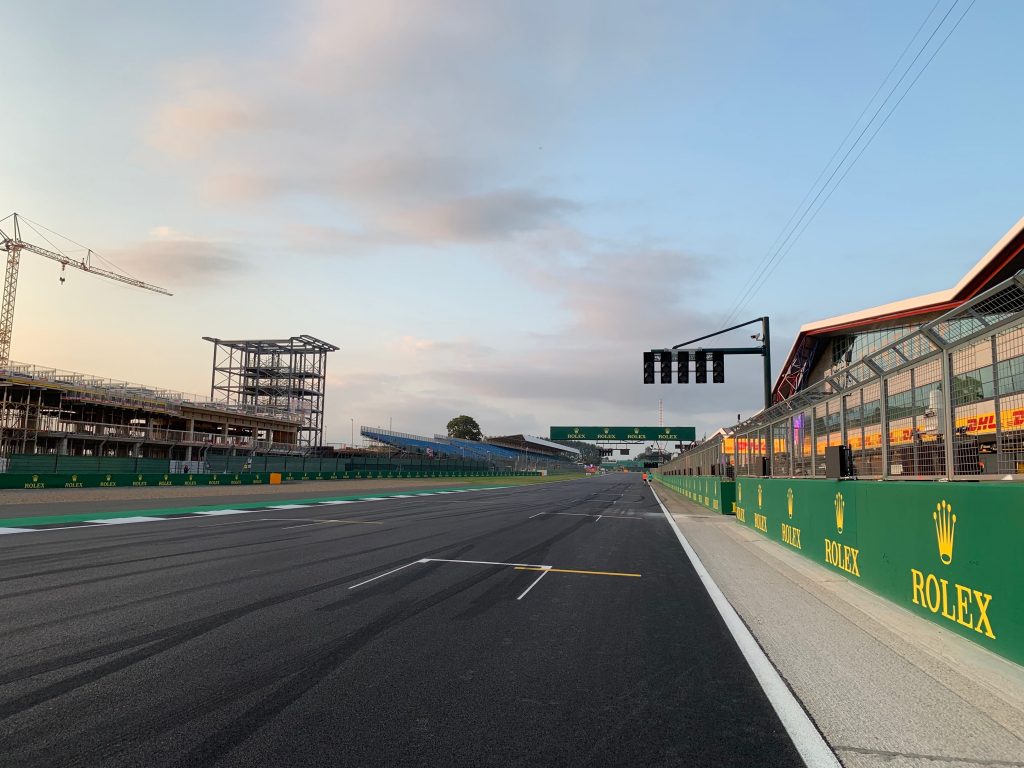
Silverstone, Great Britain
Anyone who has ever been to Silverstone will know that it is always windy, even in summer. Remember it’s an airfield. That’s kind of the point.
It was fine to complete a track run on the Saturday of the grand prix despite a fairly late finish. I’d been warned that most of the track feels like it’s uphill – and it was true. Basically all the way from the start line to the Maggots/Becketts complex is a gradual incline, meaning that while the pace wasn’t amazing through that section, I’d be able to claw it back over the rest of the lap.
In all honesty, Silverstone was one of the more boring tracks to run. It’s wide, it’s flat, you’re a long way from any of the grandstands – some still had fans in at 8pm! – or scenery, it’s more a case of getting it done.
However, this does have the honour of being the only track run of the year that was accompanied by Craig David. No, seriously. Actual Craig David.
As I started out on the Wellington Straight, I could start to hear the thud of music which, as it grew louder, turned out to be Craig David performing a set as part of the weekend’s entertainment. 7 Days wouldn’t be my usual track of choice to pair up with a track run, but it put a smile on my face all the same.
The time came back to me as I got into the second half of the lap – which at 5.8km is one of the longer ones of the year – with a little encouragement from some VIPs who had decided to take some electric bikes for a ride around the circuit, seemingly after a beer or two. “Come on mate, it’s not that hard!” they said laughing, pulling up alongside me on the Hangar Straight. “I’ll race you!” I quipped back, before a quick burst to move clear of them. They soon belted off into the distance.
Silverstone’s hardly my favourite track in the world to either work at or to run. But it was nice to tick my home race off the run list.
Time: 33:31 – 5:45/km
Hockenheim, Germany
If Austria was difficult, then Hockenheim looked like it was going to be even harder as a heatwave hit Germany in the early part of the grand prix weekend.
The temperature read 39°C as I made my way out onto the track to meet up with my friend Charlie, who, working his first grand prix – what a race to be your first! – wanted to go for a track run. If I was going to cook running the track, then at least I’d have some company.
We set off at a fairly gentle pace chatting for the first couple of kilometres (also dodging some coaches doing circuit safaris) before I told him to go ahead when we exited the harpin, as I’d probably slow him down. But as I got towards the left-hander at Turn 8, we were level – and I started to pull away. I was able to sustain my pace really well despite the heat, eventually putting the afterburners on through the final stadium section to cross the line about a minute clear of Charlie – and less out of puff than I thought I would be given the heat. It also turned out I’d finished lap quicker than another of the regular track runners.
Maybe I wasn’t as painfully slow as I thought I was. It was a nice moment where the penny dropped: Hey, you’re alright at this!
As for the track itself? Hockenheim is really easy. It’s flat as anything, meaning it’s perfect for a quick time. Hopefully this year when I run it again, it’ll be a little cooler to allow for a quicker time.
Time: 26:03 – 5:44/km
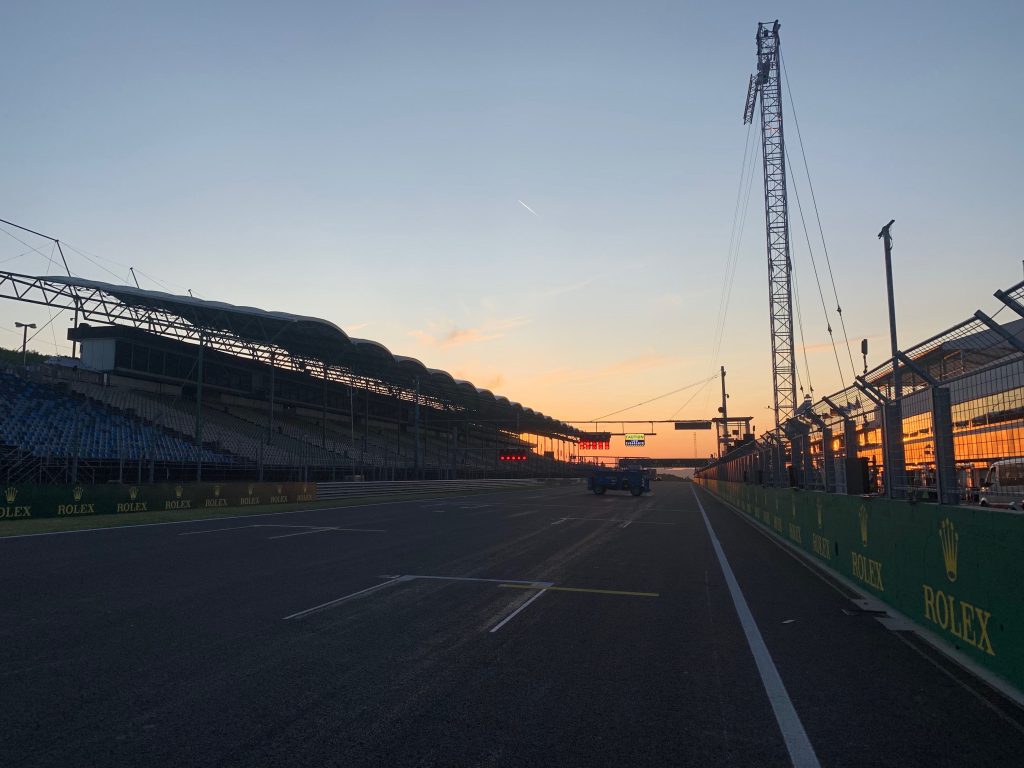
Hungaroring, Hungary
One week later, we were in Budapest, Hungary, often one of the most entertaining races of the year and certainly one of the best cities. After how well Hockenheim had gone, I was hopeful of another good run around the short, tight 4.3km track.
And it started oh-so-well. The first kilometre split came in at a pace of 5m10s – way better than my usual average – and it had me thinking about a huge PB.
But then it went downhill. Or actually, uphill. You see the first kilometre at the Hungaroring takes you from the start line to the bottom of the hill at Turn 4. From there, you’re then on a steady incline for the next 2km or so, with a number of changes of direction due to the tight and twisty middle sector. My knees were starting to yell at me, and the time splits dropped off.
Things started to drop down again as I came towards the final sector split, but then the final two corners are again gradually uphill. It was a total elevation gain of 53 metres over the lap.
Still, it was a PB pace for a track run, even if I didn’t feel entirely happy with how it panned out.
Time: 24:16 – 5:38/km

Marina Bay Street Circuit, Singapore
If Hockenheim had been hot, then surely I’d be alright in the awful humidity and heat of Singapore – even if not for the extremely polluted air. Right?
Timezones are hard to track when you cover this race. You’re eight hours ahead of Europe, yet need to stay on European time as it’s a night race. That means bedtime is 6am and you get up in the middle of the afternoon. One way to kill some time after finishing work was to do some sport (or go drinking!), so football on the Thursday night was good to sweat out some of the beers from the night before.
But the timezone challenge means sleeping can be tricky as well. Come Friday, I’d managed about five hours sleep in the past two nights, and felt like death. So when the idea of a group track run came up, with staggered starts so we could make it a race (yes we’re competitive…), I was sceptical I could do any good.
A group of five of us took our average times from Hungary and worked out the start times. I would be first to set off, with the fastest of the group, Chris, beginning his lap some eight minutes later.
I thought, fuck it. Push like mad early, try to stay ahead of the others, and if you fall apart late in the lap, then so be it. Just stay ahead as long as you can.
So I started, and pushed and pushed. The split times were quick to start with – hitting that 5:10 pace again for the first kilometre – but I doubted I’d be able to sustain them, especially when trying to dodge various trucks and cars completing track repairs.
But the times stayed stable. 2km, 5:14. 3km, 5:20. And still no sign of anyone behind.
4km came, 5:31, but with just one-and-a-bit to go, I kept pushing, panting for polluted air.
It wasn’t until I came onto the final short straight before the double-left hander to finish the lap that I realised I could win this. As I came to Turn 22, I heard a shout: “C**T!” as Chris, the last starter, made his fourth overtake. But he couldn’t make a fifth – I crossed the line, winning the staggered race.
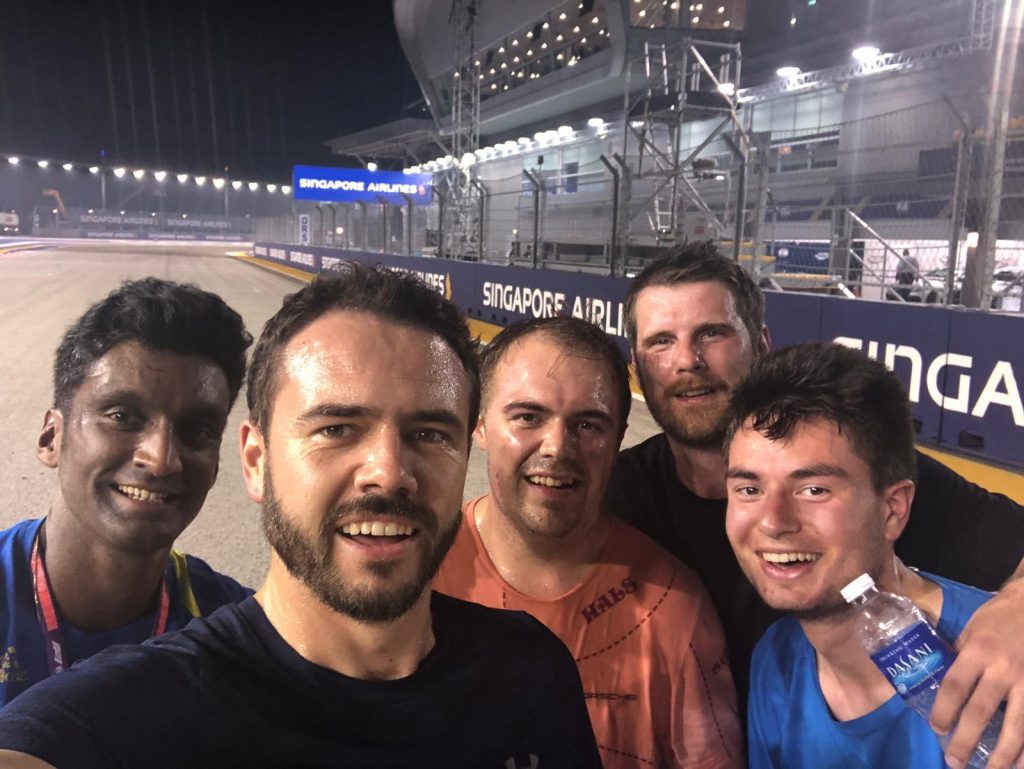
What’s more is that I also set a personal best pace for not just a track run, but any run ever. The 5km time was 26:34, shaving 41 seconds off my PB, and the final average pace of 5:18 was way better than anything I’d managed before.
But it makes sense. An F1 track is literally the perfect place to run if you want a PB. It’s (normally) flat, it’s got wide expanse, and little to hold you up. It’s not like running in a park where you often have to negotiate gates, dog walkers and small children on scooters.
I slept sound that night.
Time: 27:44 – 5:18/km
Sochi Autodrom, Russia
I hoped Sochi could be a similar story, especially without the same kind of air pollution or humidity of Singapore. We again decided to do a staggered race, with me setting off third out of five this time around.
But I couldn’t manage the kind of pace I did in Singapore. Sochi is 700 metres longer and far less interesting to run – as bland as watching the F1 races there – and I spent the first part of the lap messing about with my headphones as they weren’t working properly (racing driver excuses, blah blah). I got passed by both of the runners who started after me, eventually crossing the line with an average pace of 5:35.
But as a friend always says to me after a bad run, “you’re lapping people sat on their sofa”, which is very true. So I was glad to have done it.
There’s really not that much memorable otherwise about this track run, which probably says a lot!
Time: 33:18 – 5:35/km
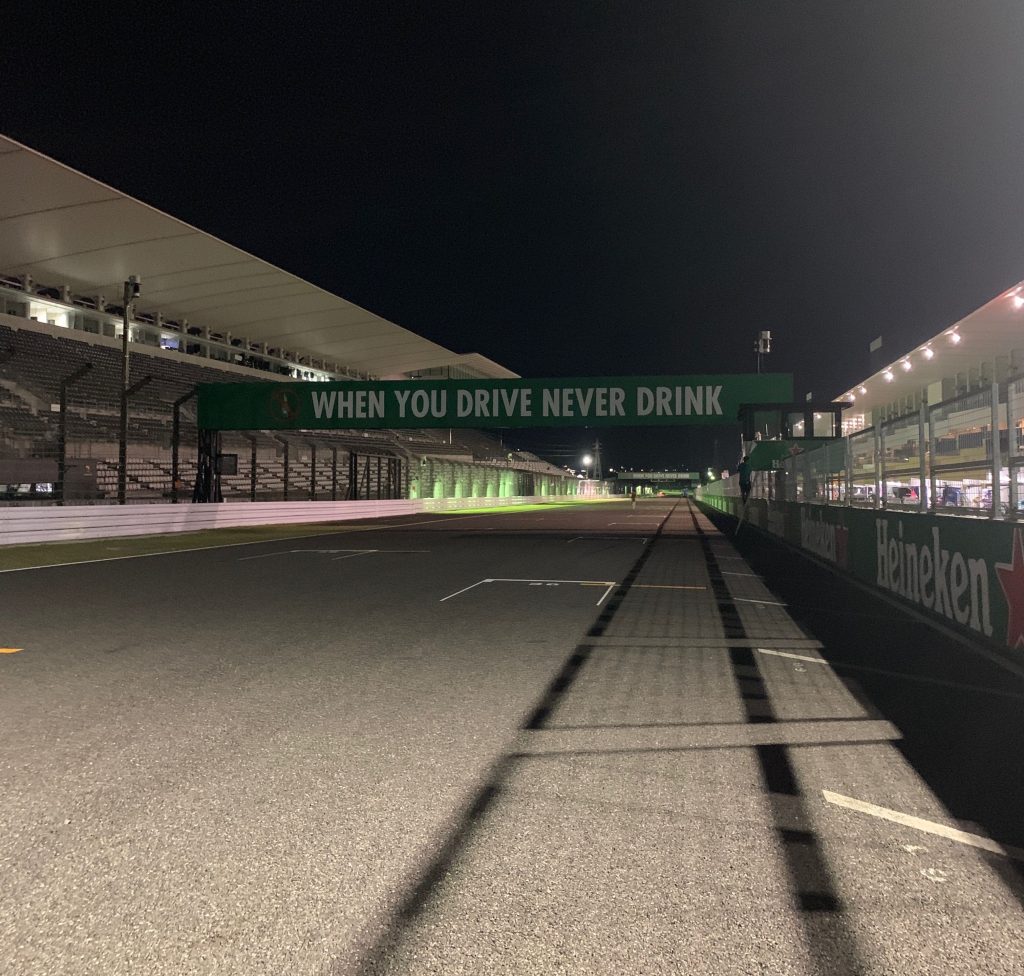
Suzuka, Japan
My final track run of the year came at the Japanese Grand Prix, towards the end of a two-week trip that included two Rugby World Cup matches, WEC at Fuji, plenty of beer and plenty of questionably-sung karaoke. Hardly ideal preparations for running…
Nor was the incoming Typhoon Hagibis which was due to impact the entire Suzuka weekend.
A mountain of work meant I didn’t get the chance to run on the Thursday, which, with the typhoon due to arrive in the early hours of Saturday, seemed to close the window completely.
But after getting things finished early on the Friday night – given there would be nothing at all happening on Saturday, with all sessions cancelled due to the incoming typhoon – and with no sign of early rain or wind, I decided to squeeze in a quick run while there was time, complete with my new ‘brave blossom’ Japan rugby shirt.
The track run felt a bit eerie. It was completely dark, and there weren’t many people out completing preparations for the typhoon as most of it had been done already. But I was still able to enjoy running one of the greatest tracks in the world.
Similar to Silverstone, the lap feels like it is all uphill from Turn 1 to Spoon, basically. You climb, and climb, and climb, and then even when you get on the straight going downhill towards 130R, there’s another slight incline before things finally flatten out for good on the run towards the final chicane.
It felt like a great run, even if the time wasn’t brilliant (averaging 5:49 per kilometre), and felt almost cheeky – take that, typhoon, you’re not stopping me run!
Towards the end of the esses in the first sector, I drew close to one of the older Japanese journalists who attends every race. I soon noticed that he was running around the track barefoot.
I sat about 100 metres or so behind him for most of the lap before finally closing up in the final stages, eventually passing through the downhill run from the final corner to the finish line. There’s always ‘targets’ you have when running, trying to pace yourself against someone – it just so happened he was mine.
I headed back to the media centre, and soon felt a tap on the shoulder. “It was YOU!” the journalist said, faking annoyance and laughing. I explained how he’d been my marker for the whole lap, and then saw his feet were covered in bruises.
“Why do you run barefoot?” I asked. “It looks so painful.”
“It’s better that way. I did a 100km marathon last weekend – all barefoot.”
I was so impressed – and it also served as a reminder of the lives away from the track that we so often forget. This was a journalist who I saw at most races, sat with at media sessions, but otherwise knew nothing about. No matter how quick or good you are, to have the will to run a 100km races – without any shoes! – is pretty astonishing.
Time: 33:31 – 5:49/km
While I was sad not to be able to complete any more track runs through the rest of the year, it didn’t stop me getting out back in the UK. I completed three 10km races over the year – two in December! – and tried to head even just for a short run around the park as often as I could.
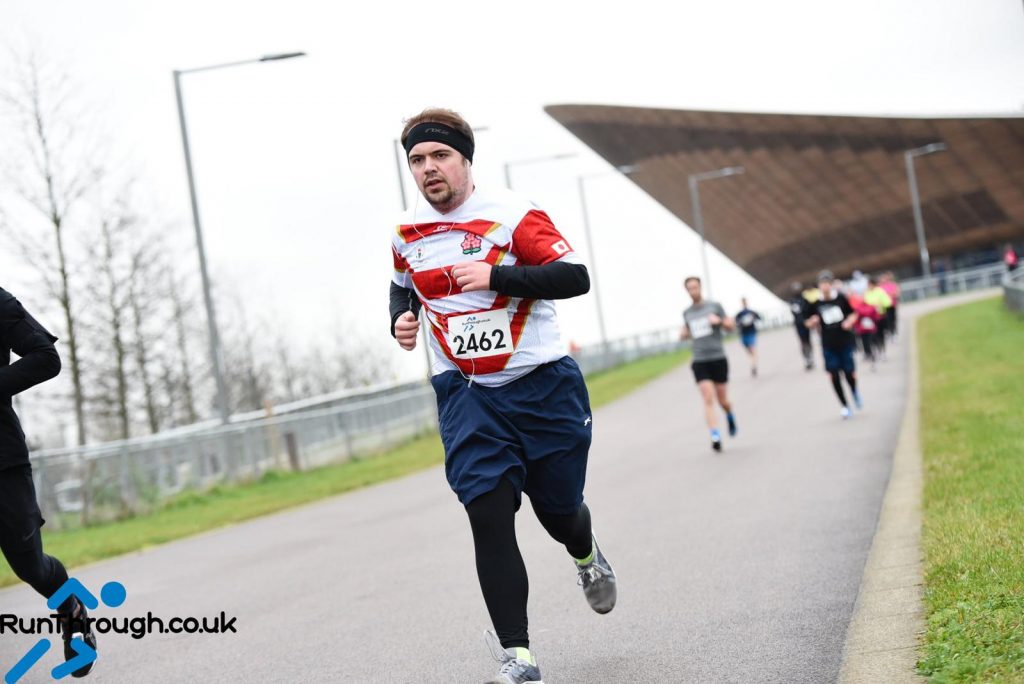
And the early targets I set? They were comfortably surpassed.
The target of doing a 5km in under 30 minutes was beaten by 3 minutes, 26 seconds.
The target of doing a 10km in under an hour was beaten by 5 minutes, 6 seconds.
And, just to complete the full Running Wanker aesthetic, I found some great books on not just running itself, but the culture surrounding it. I think reading them is what made me want to write this blog.
The best was What I Talk About When I Talk About Running by Haruki Murakami (hence the title of this piece), a stunning fiction author who is also a prolific runner. He writes about how you are able to get your mind into a state when you run where you think about nothing except the act itself – and how you get total clarity in doing so.
Murakami’s mantra was also to never stop when you run, wanting his gravestone to read “Writer (and Runner). At Least He Never Walked”. It was something I felt glad to have honoured by doing every track run without any stops.
To find any new hobby or activity is always fun and exciting. But with running, I feel like I’ve really fallen into something that not only has huge health benefits – I’m 5 stone down on my peak weight from a few years back – but also gives a competitive edge. You’re battling yourself with every single run, trying to get better, to go faster, or go further.
I’m really excited to see where that leads in 2020. Hopefully I’ll have a complete set of track runs to look back on then!
